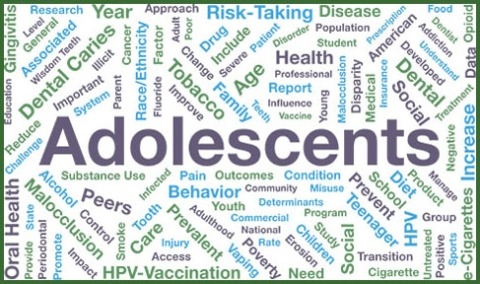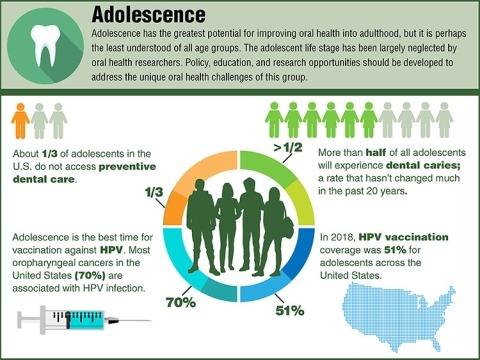Oral Health in America - March 2022 Bulletin
Section 2B Summary
Oral Health Across the Lifespan: Adolescents
Adolescence—the stage of life between ages 12 and 17 where youth mature into young adults—is often overlooked in activities to study, evaluate, and improve oral health. Often, emphasis is aimed at younger children or adults. However, adolescence is a pivotal time in life for adopting behaviors that affect an individual’s overall health and well-being. Social determinants of health, parental behaviors, and peer influence have a powerful impact on adolescent oral health in ways that still are not well understood. Age-appropriate dental interventions, reinforcement of positive oral health habits, and dietary choices can influence oral health far into adulthood.
Status of Knowledge, Practice, and Perspectives
High caries experience in early childhood is the single strongest predictor of caries experience in adolescence and adulthood. In general, if the factors influencing caries risk in childhood persist, the incidence of caries affecting permanent teeth will continue to increase during adolescence. Likewise, malocclusion of the permanent teeth that manifests in adolescence can substantially impact eating, speech, periodontal health, and psychosocial development.
Dental erosion and dental injuries are also common among adolescents. Eighteen percent of those aged 12 to 15 years and 22% of those aged 16 to 19 have had fractures to the permanent incisors. Young men experience trauma in permanent teeth more often than women, but this trend is likely changing as the participation of women in contact sports is increasing.
Advances and Challenges
The recognition that adolescents’ oral health needs are distinct from those of children and adults is an important advancement in the twenty-first century. The progress made in increasing sealant placements for adolescents has helped to dramatically reduce the income and race-related disparities for this important preventive service. During the past 20 years, the prevalence of at least one sealed permanent molar in adolescents aged 12−19 has nearly tripled, increasing from 18% to 48%. However, there has been no decline in untreated tooth decay in adolescents since the last surgeon general’s report twenty years ago. Importantly, oral diseases of adulthood begin in adolescence including periodontal disease, painful temporomandibular joint disease, sexually transmitted infections, and human papillomavirus infection. Adolescence provides an optimal opportunity for intervention including development of positive oral health habits and administration of the cancer prevention HPV vaccine. Immigrants, LGBTQ adolescents, those in foster care or the juvenile justice system, or those from underserved geographic areas are at the greatest risk for poor oral health outcomes and often are underrepresented in research.
The use of many tobacco products among adolescents has declined, with implications for positive outcomes for oral health. But these gains are tempered by the growth of e-cigarette usage during this same time.
Expansions in public insurance programs have helped increase the percentage of adolescents with dental coverage; however, disparities with regard to dental disease remain a challenge for this group.
Promising New Directions
Recent high-profile health problems among adolescents—including the opioid epidemic, binge drinking in males, rising marijuana use, teen suicide, vaping, and the prevalence of dental caries in poor and minority teens—revealed a need to turn our attention toward this significant part of the lifespan. Within the past few years, initiatives were launched that focused on reducing prescriptions of opioid painkillers after wisdom tooth removal and promoting the importance of preventive oral healthcare.
Additional Takeaways
Although dental caries continues to be the major oral disease in adolescents, other conditions such as gum disease, dental erosion, sports-related oral injuries, and misalignment of teeth are concerns that may first appear in this stage of life. Adolescence has the greatest potential for improving oral health into adulthood, but it is perhaps the least understood among all age groups, and it has been largely neglected by researchers.
Q&A with Section Editor
A conversation with Paul S. Casamassimo, DDS, MS. He served as senior editor for report Section 2B: Oral Health Across the Lifespan: Children.
What are the most important takeaways about this section?
If you read this section carefully and reflectively, you have to see that adolescents in the oral health system face the same uncertainties and challenges they face in their transition from childhood to adulthood in society.
Our system hasn’t quite figured out the adolescent patient, and continuing dental caries and emerging issues of malocclusion and soft tissue infection, among others, emphasize that oral conditions are intertwined with social factors; however, those factors are often far more difficult to untangle in pursuit of oral health for this group than for others.
If there is one major takeaway that the editors and writers want readers to glean, it is the same one that teens have told us one way or another, forever: pay attention to us, we are not children anymore and our lives and challenges are unique to us.
What was a surprising finding?
One can only be amazed, surprised, and a little dismayed at the array of social and age-related influences that an adolescent can bring to the dental office! Many teens come with life-long negative social determinants—and their consequences—which impact oral health. Some are newly affected with oral disease associated with emerging social and environmental factors and behaviors that weren’t present in childhood. And if you are a practicing oral health professional, you may find your hands full with negotiation of both oral and social health issues, some serious and challenging, for which you weren’t prepared for in professional training.
What should the American people know about this section of the report?
It would be trite to say that this section says, “teens are people too” but in some ways, and probably well known to most parents who read this section, the messages are reminiscent of the challenges teens and their parents face preparing the next generation. Some sense of relief should be taken in the recognition by section editors and writers of adolescence’s pivotal place in oral health. Children have traditionally received our greatest emphasis and most children enjoy oral health, but this report section emphasizes that adolescence is pivotal to catapult children into adulthood free of significant oral disease. The section is a new call to action and probably a welcomed change for parents and teens alike.
What is the main call to action?
There isn’t a single call to action because the section really lays out an array of challenges and new directions for our oral health care system. It may be thought of better as a wake-up call to the American oral health care system to up its game with issues like human papilloma virus (HPV), experimentation with drugs, gender emergence, changing caries patterns related to dietary freedoms, and sports injuries. Our oral health professionals need to educate and motivate as never before.
Paul Casamassimo, DDS, MS, is a professor emeritus of pediatric dentistry at the Ohio State University. He received his dental degree from Georgetown University and master’s degree in pediatric dentistry from the University of Iowa. His research focuses on children with special oral health care needs and health policies.
Did You Know?
Learn more about Oral Health in America: Advances and Challenges
July 2024




